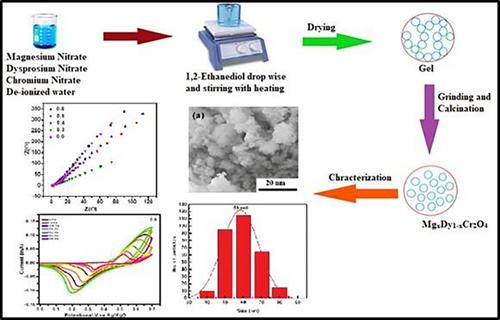A comprehensive examination of structural modifications, optical characteristics, and electrochemical analysis of magnesium-doped dysprosium chromite
Abstract
Background
This study focuses on the synthesis of magnesium-doped dysprosium chromite via a sol-gel method. The investigation aims to understand the morphological and structural properties of the synthesized nanochromates. Key techniques employed include x-ray diffraction (XRD), scanning electron microscopy (SEM), and Raman spectroscopy.
Aims
The primary aim is to analyze the structural characteristics of MgxDy1−xCr2O4 nanoparticles with varying Mg doping concentrations (ranging from 0.2 to 0.8). Special attention is given to the crystallinity of the synthesized materials, with the goal of assessing the reliability and reproducibility of the sol-gel synthesis method.
Methods
XRD analysis is employed to identify major diffraction peaks associated with the chromate nanoparticles, providing insights into their crystallinity. SEM imaging allows for the examination of the morphological features of the synthesized materials. Additionally, Raman spectroscopy aids in further understanding the structural properties of the nanochromates.
Results
The XRD analysis reveals average crystallite sizes for MgxDy1−xCr2O4 nanoparticles at different Mg doping concentrations. Notably, an improvement in crystalline quality is observed with an increase in Mg doping from 0.2 to 0.8, indicating a high level of control achieved in the synthesis process. Cyclic Voltammetry (CV) experiments conducted using a 1M KOH electrolyte and varying scan rates (3 mV/s to 50 mV/s) demonstrate enhanced electrochemical performance of the synthesized nanoparticles.
Conclusion
The study concludes that the sol-gel synthesis method effectively produces MgxDy1−xCr2O4 nanoparticles with controlled morphological and structural properties. The observed improvement in crystalline quality with increasing Mg doping concentration suggests potential applications in fields such as photo-catalysis, where enhanced crystallinity correlates with improved photo-catalytic potential for visible light absorption.



 求助内容:
求助内容: 应助结果提醒方式:
应助结果提醒方式:


